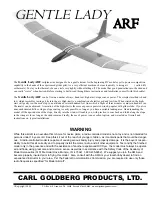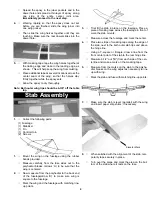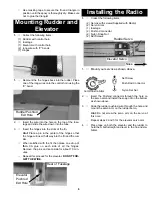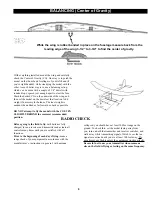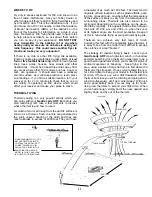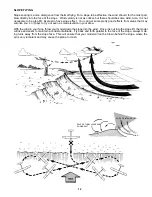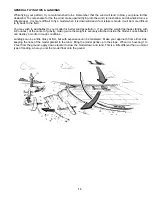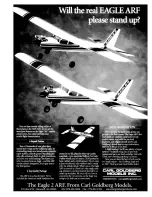
10
Flying R/C is both fun and challenging. As with other por-
tions of this book, the following section is meant to intro-
duce you to the basics. Read carefully before taking your
model out to the field and attempting first flights. And
remember, becoming an R/C pilot takes time and
patience, but the rewards are well worth the effort.
Equipment Checklist
Flight batteries, fully charged
Radio transmitter
Tools for tightening any parts that can vibrate and
loosen
Extra #64 rubber bands
Bottle of
Super Jet
™
CHECK YOUR EQUIPMENT
Prior to going to the flying field, with radio batteries fully
charged, turn on both receiver (Rx) and transmitter (Tx)
and actuate all controls many times until you are satis-
fied with all functions.
Before beginning each day's flying, make a range
check of your equipment in accordance with the manu-
facturer's instructions. In general, with transmitter
antenna collapsed to 6"-8", you should have an at least
100 foot range on the ground. To check this, turn on
both the transmitter and the receiver switches, set the
model heading away from you, and walk away while
transmitting signals to move the control surfaces.
Watch to see that no signals are missed until you are
at least 100 feet away. Only if the equipment works
perfectly should any flights be attempted. Again,
be
careful to not use your transmitter when anyone
else at the field is flying or testing on the same fre-
quency!
After the range check, stand behind the model and
make sure the control responses are correct. Moving
the control stick to the right should give right rudder (on
a 3-channel set-up) . Moving the stick back or down on
the Tx should move the elevator up, and vice versa.
Finally, make sure that everything on your aircraft is
neatly and firmly in place-motor fastened down, servos
snugged down, receiver and battery wrapped in foam
rubber, etc. The receiver antenna must be extended,
not coiled up inside the model. Nothing should be
loose, or unfinished, or unchecked.
With transmitter and receiver switched on, hand launch
the model directly into the wind. Gently correct the
flight path as necessary. If any adjustments are need-
ed to maintain straight and level flight, get experienced
help to move the clevises.
In flight control. most of the beginner's trouble comes
from over-controlling or holding a signal too long. It is
better to operate your transmitter slowly and smoothly.
A troublesome tendency is letting the model get down-
wind. New flyers should try to keep the model upwind
at all times prior to the landing approach.
If you are a novice, seek the help of an experienced
flyer. Do not hesitate to ask one of the better flyers at
the field for help. Usually, they are glad to spend a lit-
tle time to get somebody started right, and they very
likely were helped in the same manner themselves.
An experienced R/C flight instructor is strongly recommended for learning how to fly.
Learning To Fly
Summary of Contents for Gentle Lady ARF
Page 14: ......

